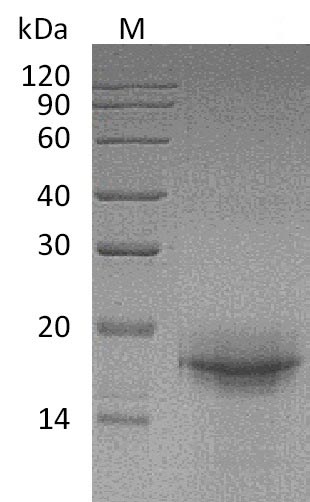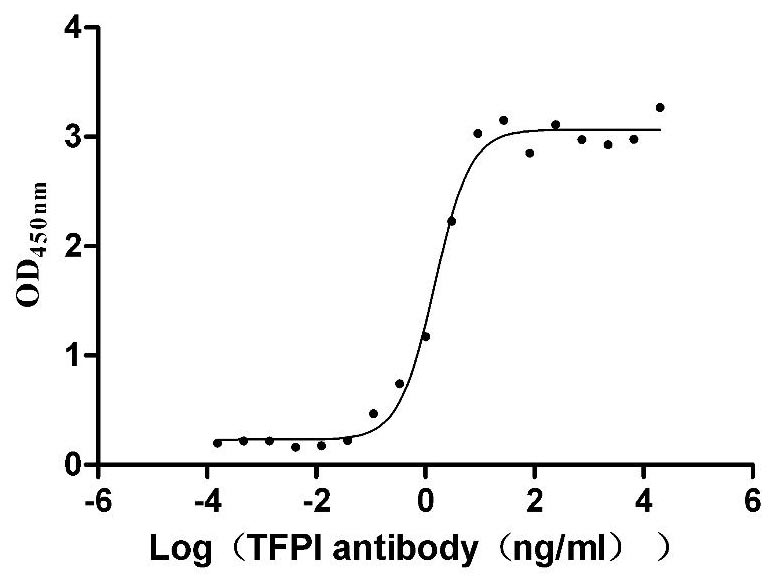Recombinant Mouse Interleukin-33 (Il33), partial (Active)
In Stock-
货号:CSB-AP004251MO
-
规格:¥1224
-
图片:
-
其他:
产品详情
-
纯度:Greater than 95% as determined by SDS-PAGE.
-
内毒素:Less than 0.01 EU/µg as determined by LAL method.
-
生物活性:Measured by its binding ability in a functional ELISA. Immobilized Mouse IL-33 at 5μg/ml can bind Mouse ST2-Fc, the ED50 of Mouse ST2-Fc is 0.33 ug/ml.
-
基因名:
-
Uniprot No.:
-
别名:Il33Interleukin-33; IL-33) [Cleaved into: Interleukin-33(102-266); Interleukin-33(109-266)]
-
种属:Mus musculus (Mouse)
-
蛋白长度:Partial
-
来源:E.coli
-
分子量:17.6 kDa
-
表达区域:109-266aa
-
氨基酸序列SIQGTSLLTQSPASLSTYNDQSVSFVLENGCYVINVDDSGKDQEQDQVLLRYYESPCPASQSGDGVDGKKLMVNMSPIKDTDIWLHANDKDYSVELQRGDVSPPEQAFFVLHKKSSDFVSFECKNLPGTYIGVKDNQLALVEEKDESCNNIMFKLSKI
-
蛋白标签:Tag-Free
-
产品提供形式:Liquid or Lyophilized powder
Note: We will preferentially ship the format that we have in stock, however, if you have any special requirement for the format, please remark your requirement when placing the order, we will prepare according to your demand. -
缓冲液:Lyophilized from a 0.2 μm filtered PBS, 1mM DTT, pH 7.4.
-
储存条件:Store at -20°C/-80°C upon receipt, aliquoting is necessary for mutiple use. Avoid repeated freeze-thaw cycles.
-
保质期:The shelf life is related to many factors, storage state, buffer ingredients, storage temperature and the stability of the protein itself.
Generally, the shelf life of liquid form is 6 months at -20°C/-80°C. The shelf life of lyophilized form is 12 months at -20°C/-80°C. -
货期:Basically, we can dispatch the products out in 1-3 working days after receiving your orders. Delivery time may differ from different purchasing way or location, please kindly consult your local distributors for specific delivery time.Note: All of our proteins are default shipped with normal blue ice packs, if you request to ship with dry ice, please communicate with us in advance and extra fees will be charged.
-
Datasheet & COA:Please contact us to get it.
相关产品
靶点详情
-
功能:Cytokine that binds to and signals through the IL1RL1/ST2 receptor which in turn activates NF-kappa-B and MAPK signaling pathways in target cells. Involved in the maturation of Th2 cells inducing the secretion of T-helper type 2-associated cytokines. Also involved in activation of mast cells, basophils, eosinophils and natural killer cells. Acts as a chemoattractant for Th2 cells, and may function as an 'alarmin', that amplifies immune responses during tissue injury.; In quiescent endothelia the uncleaved form is constitutively and abundantly ex...显示更多
-
基因功能参考文献:
- Il33 -/- mice exhibited reduced anxiety-like behaviors in the elevated plus maze and the open field test, as well as deficits in social novelty recognition, despite their intact sociability, in the three-chamber social interaction test. The immunoreactivity of c-Fos proteins, an indicator of neuronal activity, was altered in several brain regions implicated in anxiety-related behaviors. PMID: 29379874
- this paper shows that IL-33 promotes gastrointestinal allergy in a TSLP-independent manner PMID: 28656964
- our findings demonstrate the critical roles of interleukin 33 in promoting colorectal cancer development through inducing tumor-infiltrating ST2L+ regulatory T cells PMID: 29950152
- Combined blockade of the IL-13 and IL-33 pathways leads to a greater inhibition of type 2 inflammation over inhibition of either pathway alone. PMID: 27697499
- Taken together, our data provide the evidence that ST2 deficiency in early phase of sepsis downregulates myeloid precursors, inflammatory NK and dendritic cells PMID: 30001716
- data indicate that during acute, resolving colitis, IL-33/ST2 plays a crucial role in gut mucosal healing by inducing epithelial-derived miR-320 that promotes epithelial repair/restitution and the resolution of inflammation. PMID: 30224451
- IL-33 may down-regulate CLDN1 expression through the ERK/STAT3 pathway in keratinocytes. PMID: 29534857
- the release of IL-33 and GM-CSF from epithelial cells induces the activation of p65 and the p38-MK2/3 signaling module in Dendritic Cells, resulting in Th2 polarization and, finally, allergic inflammation. PMID: 29288203
- Injection of IL-21-expressing or IL-33-expressing plasmids facilitates clearance of pre-established genotype B strain designated BPS (BPS) persistence and protects cured mice from BPS re-challenge. PMID: 29242561
- In a model of sepsis, IL-33 treatment enhanced the IFN-gamma level in blood and promoted mice's survival, so the protective effects of IL-33 depend on IFN-gamma. The IL-33 treatment also promoted both gammadelta T cells and NK cells in septic mice. PMID: 29610934
- VHL-HIF-glycolysis axis is essential for the late-stage maturation and function of ILC2s via targeting IL-33-ST2 pathway. PMID: 29452935
- results therefore demonstrate that manipulation of the IL33-NLRP3 axis may be an effective therapy to suppress neuroinflammation and improve the efficacy of antimalarial drug treatment of cerebral malaria. PMID: 29954866
- Deficiency of IL-33 was associated with exacerbated atopic dermatitis -like inflammation in Stat6VT mice suggesting at least some aspect(s) of IL-33 signaling could negatively regulate disease in this model. PMID: 29368135
- this study shows novel protective mechanism for interleukin-33 at the mucosal barrier during influenza-associated bacterial superinfection PMID: 28401938
- IL-33 acts directly on bone marrow ILC2s, making them an early source of IL-5 and part of a process that is central in IL-33-driven eosinophilia. PMID: 28921511
- Blockage of IL-33/ST2 axis reduces APAP-mediated organ injury by dampening liver chemokine release and activation of resident and infiltrating liver non-parenchymal cells. PMID: 29032512
- these data provide mechanistic insight into how FAK controls the tumor immune environment, namely, through a transcriptional regulatory network mediated by nuclear IL-33. PMID: 29208683
- Thymic stromal lymphopoietin and IL-33 promote skin inflammation and vaccinia virus replication in a mouse model of atopic dermatitis. PMID: 26830114
- Results show that interleukin-33 acts to express Schaffer collateral/CA1 long term potentiation (LTP) relevant to spatial learning and memory in a myeloid differentiation factor 88 (MyD88)-dependent manner. PMID: 29147584
- IL-33 may induce Th17 cell responses via IL-1beta and IL-6 derived from IL-33-matured dendritic cells. PMID: 28802996
- Metaplasia induction and macrophage polarisation after parietal cell loss is coordinated through a cytokine signalling network of IL-33 and IL-13, linking a combined response to injury by both intrinsic mucosal mechanisms and infiltrating M2 macrophages. PMID: 28196875
- IL-33/ST2 can induce production of proinflammatory cytokines, such as TNF-alpha and IL-6, through production of IL-13 in Plasmodium chabaudi-infected BALB/c mice, suggesting that IL-33/ST2 play a critical role in inflammatory responses to malaria infection. PMID: 28359899
- these results provide new insights into the mechanisms by which intestinal epithelial cells , via IL-33/ST2 axis, may control pro-inflammatory TH17 cells in the small intestine to sustain homeostasis PMID: 28198366
- In cells pre-treated with IL-4 and IL-13, expression of mRNA for Ccl3, Ccl5, Ccl17, Ccl24, and Il1b in response to IL-33 stimulation was significantly increased. This was paralleled by up-regulated expression of miR-155-5p, a miRNA that is predicted to regulate several aspects of allergic inflammation. IL-33-activated macrophages may contribute to the exaggerated airway inflammation in exacerbations of allergic asthma. PMID: 29621782
- Mice treated with HW for 4 weeks demonstrated a significant decrease in the AD severity score compared with PW-treated mice (p less than 0.01). Hydrogen water administration also significantly reduced TEWL and serum TARC levels (p less than 0.01), infiltration of mast cells (p less than 0.05), and secretion of the proinflammatory cytokines interleukin (IL)-1beta and IL-33 (p less than 0.05) in skin lesions compared wit... PMID: 28889151
- IL-33 is necessary for activating Th2-type natural helper cells following respiratory syncytial virus-induced airway inflammation PMID: 28771101
- Study found that interleukin33 was critical for repair of aged neurons. Its deficiency caused tau abnormality and late-onset of neurodegeneration in the cerebral cortex and hippocampus, accompanied with Alzheimer's disease-like cognition and memory impairment. PMID: 28675392
- this study finds that IL-33 signals primarily to microglia under physiologic conditions, that it promotes microglial synapse engulfment, and that it can drive microglial-dependent synapse depletion in vivo. PMID: 29420261
- IL-33 cooperated with Kras and TGFbetaR2 mutations in the development of extrahepatic cholangiocarcinoma (ECC), and anti-IL-33 treatment suppressed ECC development significantly. PMID: 28439013
- Data provide clear evidence that IL-33 plays a protective role in trinitrobenzenesulfonic acid-induced colitis, which is closely related to alternatively activated macrophages polarization. PMID: 28423665
- Results show that IL-33 is significantly increased in the inflamed skin in urushiol-induced allergic contact dermatitis mice because of increased production and release from keratinocytes. PMID: 27821781
- IL-33 production induced by P. gingivalis fimbriae and lipopeptide is recognized by TLR2 and may modulate dendritic cel function in periodontal diseases. PMID: 28637954
- CLOCK temporally gates mast cell responses to IL-33 via regulation of ST2 expression. Our findings provide novel insights into IL-33/mast cell-associated physiology and pathologies. PMID: 28259547
- results suggest that alveolar Gq/11 signaling maintains alveolar homeostasis and likely independently increases TGFbeta activation in response to the mechanical stress of the epithelium and decreases epithelial IL-33 synthesis. Together, these findings suggest that disruption of Gq/11 signaling promotes inflammatory emphysema but protects against mechanically induced lung injury. PMID: 27811142
- Our data indicate that CB2 may directly contribute to the pathogenesis of eosinophil-driven diseases. Moreover, we provide new insights into the molecular mechanisms underlying the CB2 -mediated priming of eosinophils. PMID: 26864308
- IL-33 dysregulated lung Treg cells and impaired immunologic tolerance to inhaled antigens PMID: 28196763
- gut pericryptal fibroblasts release IL-33 to translate bacterial infection into an epithelial response to promote antimicrobial defense. PMID: 27184849
- Mex-3B facilitates the development of allergic airway inflammation by directly upregulating IL-33 expression via inhibiting miR-487b-3p mediated repression of IL-33. PMID: 27545879
- IL-33 promoted the new extracellular matrix deposition and angiogenesis formation, which indicates an important role of IL-33 on matrix synthesis and neovascularization. PMID: 28697404
- Data indicate that interleukin-33 (IL-33)-induced Interleukin-13 (IL-13) production by type-2 helper T cells (Th2 cells) Is dependent on epidermal growth factor receptor (EGFR) expression. PMID: 29045902
- Heligmosomoides polygyrus Alarmin Release Inhibitor (HpARI) prevents binding of active interleukin-33 (IL-33) to the IL-33 receptor. PMID: 29045903
- Despite its expression in the synovium of arthritic mice and normal keratinocytes, IL-33 is not required for collagen-induced arthritis development in arthritis or psoriasis PMID: 27317338
- The studies establish chronic pancreatitis as an IL-33-dependent inflammation resulting from synergistic interactions between the NOD1 and CCKR signaling pathways. PMID: 26813347
- study concludes that IL-33 and TSLP are required for epithelial cell IL-25 expression, mucous metaplasia, and ILC2 expansion following early-life rhinovirus infection PMID: 28701507
- Bone marrow-derived mast cells cultured in TGF-beta1, beta2, or beta3 showed reduced IL-33-mediated production of TNF, IL-6, IL-13, and MCP-1 in a concentration-dependent manner. TGF-beta1 inhibited IL-33-mediated Akt and ERK phosphorylation as well as NF-kappaB- and AP-1-mediated transcription. PMID: 28637902
- results suggest that EGF is a key growth factor that increased IL-33 production and ST2 receptor expression during intestinal inflammation and carcinogenesis; the EGF/IL-33/ST2 axis represents a novel therapeutic target in colon cancer PMID: 27300306
- Lactic Acid Suppresses IL-33-Mediated Mast Cell Inflammatory Responses via Hypoxia-Inducible Factor-1alpha-Dependent miR-155 Suppression PMID: 27559047
- Liver Treg cells show a high expression of ST2, a cellular receptor for tissue alarmin IL-33, which is strongly upregulated in the liver of infected mice. These results illustrate the importance of IL-33 in the suppressive function of liver Treg cells during Cytomegaloviruses (CMVs) infection. PMID: 28448566
- These data suggest that plasmacytoid dendritic cells producing IFN-alpha and IL-33 play a pivotal role in the chronic fibro-inflammatory responses underlying murine autoimmune pancreatitis and human IgG4-related autoimmune pancreatitis. PMID: 28373582
- In vitro IL-33 treatment abrogated MHV-3 and IFN-gamma induced FGL2 expression in RAW264.7 and THP-1 cells. PMID: 28494352
收起更多
-
亚细胞定位:Nucleus.; Nucleus. Chromosome. Cytoplasm. Cytoplasmic vesicle, secretory vesicle. Secreted.
-
蛋白家族:IL-1 family
-
数据库链接:
KEGG: mmu:77125
STRING: 10090.ENSMUSP00000025724
UniGene: Mm.182359


















